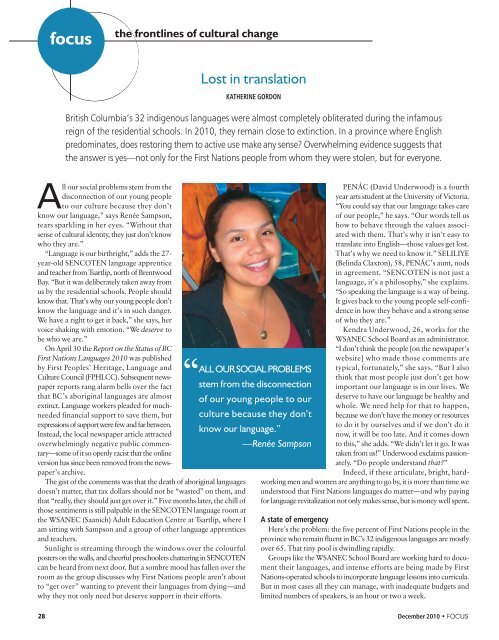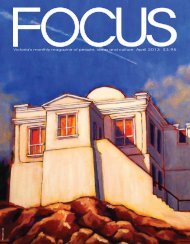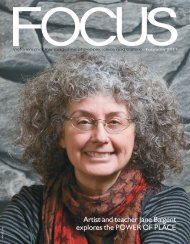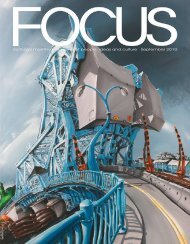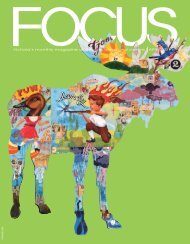****December 2010 Focus - Focus Magazine
****December 2010 Focus - Focus Magazine
****December 2010 Focus - Focus Magazine
Create successful ePaper yourself
Turn your PDF publications into a flip-book with our unique Google optimized e-Paper software.
focus<br />
the frontlines of cultural change<br />
Lost in translation<br />
KATHERINE GORDON<br />
British Columbia’s 32 indigenous languages were almost completely obliterated during the infamous<br />
reign of the residential schools. In <strong>2010</strong>, they remain close to extinction. In a province where English<br />
predominates, does restoring them to active use make any sense Overwhelming evidence suggests that<br />
the answer is yes—not only for the First Nations people from whom they were stolen, but for everyone.<br />
All our social problems stem from the<br />
disconnection of our young people<br />
to our culture because they don’t<br />
know our language,” says Renée Sampson,<br />
tears sparkling in her eyes. “Without that<br />
sense of cultural identity, they just don’t know<br />
who they are.”<br />
“Language is our birthright,” adds the 27-<br />
year-old SENCOTEN language apprentice<br />
and teacher from Tsartlip, north of Brentwood<br />
Bay. “But it was deliberately taken away from<br />
us by the residential schools. People should<br />
know that. That’s why our young people don’t<br />
know the language and it’s in such danger.<br />
We have a right to get it back,” she says, her<br />
voice shaking with emotion. “We deserve to<br />
be who we are.”<br />
On April 30 the Report on the Status of BC<br />
First Nations Languages <strong>2010</strong> was published<br />
“<br />
by First Peoples’ Heritage, Language and<br />
Culture Council (FPHLCC). Subsequent newspaper<br />
reports rang alarm bells over the fact<br />
that BC’s aboriginal languages are almost<br />
extinct. Language workers pleaded for muchneeded<br />
financial support to save them, but<br />
expressions of support were few and far between.<br />
Instead, the local newspaper article attracted<br />
overwhelmingly negative public commentary—some<br />
of it so openly racist that the online<br />
version has since been removed from the newspaper’s<br />
archive.<br />
The gist of the comments was that the death of aboriginal languages<br />
doesn’t matter, that tax dollars should not be “wasted” on them, and<br />
that “really, they should just get over it.” Five months later, the chill of<br />
those sentiments is still palpable in the SENCOTEN language room at<br />
the WSANEC (Saanich) Adult Education Centre at Tsartlip, where I<br />
am sitting with Sampson and a group of other language apprentices<br />
and teachers.<br />
Sunlight is streaming through the windows over the colourful<br />
posters on the walls, and cheerful preschoolers chattering in SENCOTEN<br />
can be heard from next door. But a sombre mood has fallen over the<br />
room as the group discusses why First Nations people aren’t about<br />
to “get over” wanting to prevent their languages from dying—and<br />
why they not only need but deserve support in their efforts.<br />
ALL OUR SOCIAL PROBLEMS<br />
stem from the disconnection<br />
of our young people to our<br />
culture because they don’t<br />
know our language.”<br />
—Renée Sampson<br />
PENÁC (David Underwood) is a fourth<br />
year arts student at the University of Victoria.<br />
“You could say that our language takes care<br />
of our people,” he says. “Our words tell us<br />
how to behave through the values associated<br />
with them. That’s why it isn’t easy to<br />
translate into English—those values get lost.<br />
That’s why we need to know it.” SELILIYE<br />
(Belinda Claxton), 58, PENÁC’s aunt, nods<br />
in agreement. “SENCOTEN is not just a<br />
language, it’s a philosophy,” she explains.<br />
“So speaking the language is a way of being.<br />
It gives back to the young people self-confidence<br />
in how they behave and a strong sense<br />
of who they are.”<br />
Kendra Underwood, 26, works for the<br />
WSANEC School Board as an administrator.<br />
“I don’t think the people [on the newspaper’s<br />
website] who made those comments are<br />
typical, fortunately,” she says. “But I also<br />
think that most people just don’t get how<br />
important our language is in our lives. We<br />
deserve to have our language be healthy and<br />
whole. We need help for that to happen,<br />
because we don’t have the money or resources<br />
to do it by ourselves and if we don’t do it<br />
now, it will be too late. And it comes down<br />
to this,” she adds. “We didn’t let it go. It was<br />
taken from us!” Underwood exclaims passionately.<br />
“Do people understand that”<br />
Indeed, if these articulate, bright, hardworking<br />
men and women are anything to go by, it is more than time we<br />
understood that First Nations languages do matter—and why paying<br />
for language revitalization not only makes sense, but is money well spent.<br />
A state of emergency<br />
Here’s the problem: the five percent of First Nations people in the<br />
province who remain fluent in BC’s 32 indigenous languages are mostly<br />
over 65. That tiny pool is dwindling rapidly.<br />
Groups like the WSANEC School Board are working hard to document<br />
their languages, and intense efforts are being made by First<br />
Nations-operated schools to incorporate language lessons into curricula.<br />
But in most cases all they can manage, with inadequate budgets and<br />
limited numbers of speakers, is an hour or two a week.<br />
28 December <strong>2010</strong> • FOCUS


